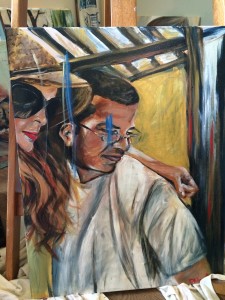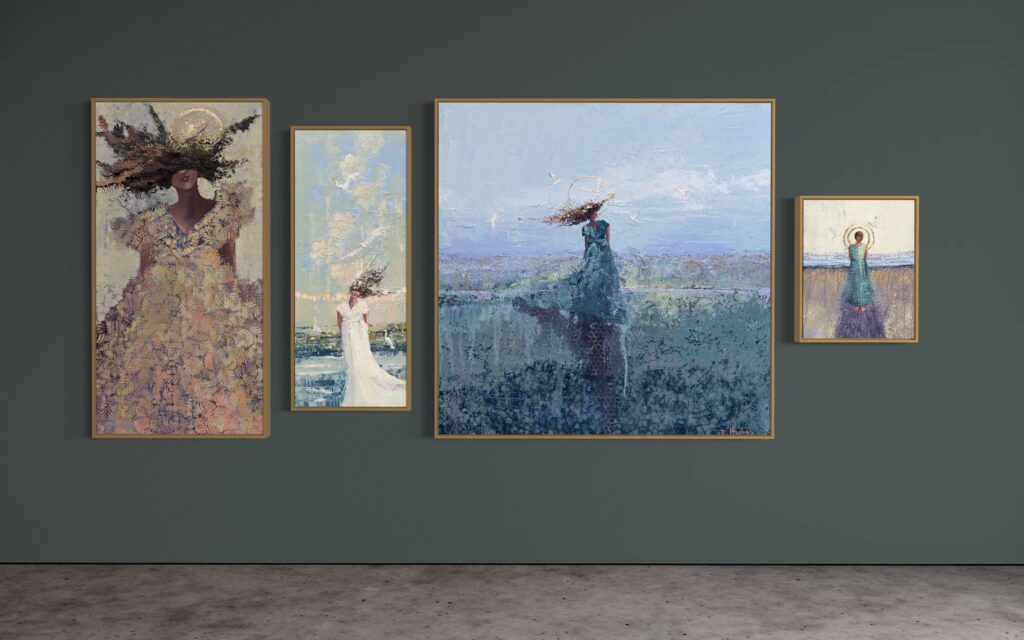Art and Warring
Home > Art and Warring
“Waiting for the Muses”, 22×28, oil on canvas, $312 [button link=”http://www.dailypaintworks.com/fineart/denise-hopkins/waiting-for-the-muses/243429″ type=”big”] Buy Now[/button]
This one has been a long time coming.
In the mess of my separation and still eventual divorce, I have things, objects, that don’t quite have a home in this temporary space I’ve found myself– someone else’s home.
Old paintings. Paintings whose images and whose style represent a person that I used to be. I have stacks of them. In my mind, the act of painting over some of the paintings I’d done of or for my ex-husband was therapeutic– a beautiful, transformative, glorious moment complete with appropriate melo-dramatic soundtrack, tears, perhaps even trumpets. If my life were a movie, I pictured this a pivotal scene. I often imagined smearing black paint over the entire canvas before beginning the real work of transformation although I neither own nor have I ever used black paint. For a moment I considered buying some.
I read The War of Art a couple days ago on a plane, and it shook me to my core. In it Steven Pressfield describes resistance as that ominous, self-induced monster that demonstratively and aggressively keeps you from doing your work– ice cream, golf, TV, your day job, and, for me, fear. I didn’t want to revisit images I thought, I knew, would be painful. As though in this movie scene I’d oh-so artistically fashioned, the psychological torment would be too great to bare, and I’d crumble under the weight of its intensity. I’d rather just not face it and, instead, face only my ambition to face it– and perhaps eat some ice cream.
Reality: I was painting a commissioned piece, got blue paint on my hand and needed a place to wipe it. The painting I’d done years ago of my ex-husband and me on our honeymoon was poking out from a stack of canvases in the corner of my studio.
Now.
An inner voice beckoned, “Now!”. I promptly obeyed, and wiped my fingers against our faces.

It felt good. Not great. Not momentous or tragic. Just good. I did it some more.
Okay. Now, I could begin.
And for those who don’t know this, I am an incredibly lazy and irresponsible painter. I paint over images without sanding down the textures of the previous image to create a smooth surface. I rarely clean my brushes.
Because I hadn’t sanded out the texture, the bumps and rivers of the previous painting had to be dealt with because having been prompted by the muses (seriously if you haven’t read War of Art, read it now) with a resounding NOW, I was not about to stop to do something as unrewarding as preparing my surface. The answer was in the palette knife. What would bumps matter if they were under a multiple of new bumps and ridges?
I’d been wanting to paint this heron. Had spent far too much time wondering what the appropriate image would be to replace one so riddled with pain. The truth is that it never mattered what I painted. The act of painting (regularly) itself is profound enough. So I painted this heron and, of all the paintings I’ve done in the last few months, I am the most proud of it. Not because of any psychological voo-do that took place in the act of painting over an old image, but because I love the texture, the color, the scrapes and scratches.
Denise Hopkins
July 10, 2014
Share Post
blog
Related Blog Posts
July 2024, New Work Preview!
After kicking off 2024 with a (mostly) small painting a day in my annual 31 in 31 practice, I was...
Day 31. If you want to go far…
“If You Want to go Far” 24×30 inches, oil on canvas I started this month with a bike, and...
Day 30. Reteach a thing its loveliness.
“The Bud Stands for All Things” 24×24 inches, oil on paper I discovered this poem last week by Galway Kinnell...

Join the Denise Hopkins Fine Art VIP Club Today
Become a member and enjoy early access to new releases, exclusive discounts, and a new wallpaper for your computer or tablet. Elevate your art journey with us.





3 Responses
Beautifully written post and beautiful painting. Although I should have assumed, I didn’t know you had read War of Art. It’s one of my favorites.
Thanks, Greg. It’s one of those books I’ll keep coming back to for sure.